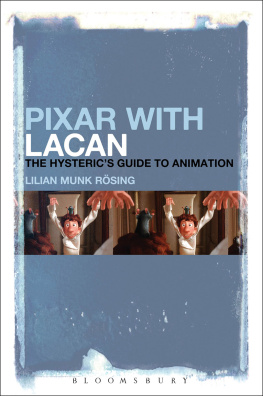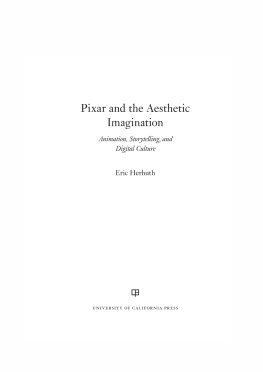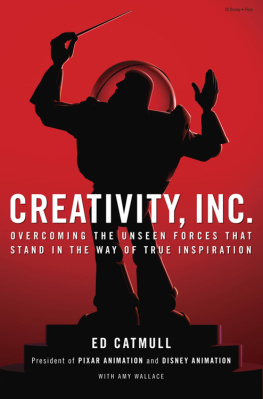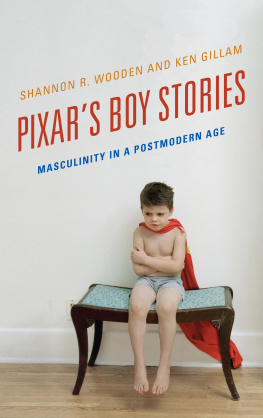For Aron and Josef

Contents
The technique of animated films seems to carry within it, as a kind of meta-reflection, the very philosophical problem of animation. What does it take to animate a thing or an animal? That is, what is a soul (Latin: animus)? How is something humanized? Psychoanalytically speaking, how is the subject constituted? What makes the subject tick, what animates the human subject (as different from the thing or the animal)? Pixars animated universe seems to me not only to present its creators with this problem, but also to have it as a recurring theme. Or, put another way: the problem of animation seems to expand from being a problem of production to defining to a large degree the themes and stories of the films. In the terms of animation theorist Alan Cholodenko, animation is here both trope and device (Cholodenko 2007: 60).
The rat in Ratatouille is perhaps the clearest image of this. The film is about a rat who installs himself in the toque of a kitchen boy, pulling his hair like the puppeteer pulls the strings of his puppet, directing him to cook delicious dishes gaining him the reputation of a master chef. The central image of the whole story is thus a kind of imaginative answer to the question: What animates the human being, what is his soul? The answer is a rat!
Pixars very first feature film, Toy Story, is not just about living toys, but about toys becoming alive. That is, again, the characters are not just animated toys, the process of animating them becomes a part of the story, the question of what animates them becomes an important theme. At first animated by the childs play, which thus becomes a kind of allegory of the animators work, they soon show themselves to be animated by gaze and voice. The fantasy of toys becoming alive is not only what created the film, but also, in Toy Story, a decisive part of the plot, used to conquer the villain.
This self-reflexivity of animation was one of Sergei Eisensteins important points in his enthusiastic notes on Disney from the 1940s. Eisenstein saw how Disneys cartoons were animated twice: both in the sense of making drawings come alive, and in the sense of animating, that is humanizing, the animals that were the characters (Eisenstein 2011: 43).
This duplicity of animation technique and theme, device and trope may explain why animations characters are prototypically animals and things being animated into humans. As the animation historian Donald Crafton observes about the normally inanimate objects of everyday life furniture, tools, toys that were the subjects of animation from its early days: These subjects, then, however haunted, were also representations of animators enduring concern with autokinesis, movement in itself, the stuff of animation. Craftons point is that the animated thing from one (animist) point of view is haunted, but from another (mechanist) view rather reflects the technical inventions of the turn-of-the-century, the automobile and the aeroplane: objects moving with what seemed their own internal life. (Crafton 1982: 32). The zone where soul and mechanics meet, comically or uncannily, will in this book be a meeting place for animation and psychoanalysis.
The most difficult figure to construct in computer animation is apparently the human figure. In the beginning of Pixars story of developing the technique of computer animation, the flexibility, skin and face of the human body presented the animators with great difficulties. Human characters are difficult to present in our medium, as director Jan Pinkava puts it on the commentary track to the early Pixar short film Geris Game. This technical difficulty in constructing a human being highlights the question of what a human being is.
Pixar has been leading in developing the technique of computer animation. They have had enormous success in animating the inanimate, constructing the human. Their films will be the object of analysis in this book, taking its point of departure from the interest that Pixar shares with psychoanalysis: What distinguishes the human subject from animals and things?
What animates the subject, according to Pixar? What animates the subject, according to psychoanalysis? These two questions will be examined in parallel in the following analyses of Pixars films. It will be shown how the human subject is animated by desire, language, gaze and voice, but also how these distinctive human features paradoxically even function as some kind of alien mechanism in the subject.
The alien in control
One of the first Pixar shorts, Reds Dream (John Lasseter, 1987), a remarkable mixture of slapstick and film noir, is about the unicycle Red standing in the corner in a bike shop, on sale. The unicycle is provided with a mind as the camera dives into its saddle and shows us the dream going on there. He dreams that he is in the circus underneath a juggling clown in front of an audience, and that he detaches himself from the clown and starts juggling himself. Again, Pixar not only gives us an animated unicycle, but the very process or scene of its being gradually animated, culminating in the prop taking over the agency of the human performer.
In Reds Dream the unicycle is animated by three things: dreaming, juggling and having an audience. These seem to correspond to some of the important principles that psychoanalysis presumes to animate the human subject. As Sigmund Freud argued in his Traumdeutung, dreams are the royal road to the unconscious, which is finally what animates the human subject. The repetitive, mechanical activity of juggling has the dynamics of that compulsion to repeat what Freud named the death drive. And finally, the audience is what Jacques Lacan would call the big Other, the gaze before which we perform our lives, also when we are completely solitary. The feeling of being watched, of being the object of some kind of perception that knows what we want and how we ought to be and behave, is what Lacan calls by the name of the big Other.
The clown in Reds Dream was, according to the commentary track, one of the first organic forms made by Pixar. Finally, one might wonder whether the clown does not seem somehow more mechanical, more thing-like than the unicycle. As a collision between the mechanical and the living he has something of the Bergsonian comic about him. To Bergson the application of something mechanical to the supple and living has a comic effect (Bergson 1999: 39). But then again, the mechanical dimension expressed in the monotonous juggling may very much be the very drive that animates the human being, the compulsion to repeat.
On the commentary track to Reds Dream we hear from director John Lasseter that he is proud of the end, because it has the pathos that according to his mentors at Disney should be put into animation. Finally, being animated also means being moved, as Sianne Ngai points out when defining animatedness (or innervation, agitation) as one of the most basic ways in which affect becomes socially recognizable in the age of mechanical reproducibility, implying the most basic or minimal of all affective conditions: that of being moved (Ngai 2005: 91).
In a later short film, Lifted (Gary Rydstrom, 2006), the theme of animation is obvious; the film is about a sleeping man being animated by green aliens from a UFO, and from the commentary track it is clear that this theme also has the meta-level of referring to the work that goes into the making of animated films. The film is instructed by Gary Rydstrom, a famous sound-guy at Pixar, and on the commentary track he explains how he sees it as an allegory of his own career, identifying himself with the student alien Stu who is sweating at the mixing console, supervised by his instructor Mr B. In a highly comical plot Stu really has problems directing the beams that are to lift up the sleeping man into the UFO, and when he finally succeeds, he lets go of the button too early, sending the man back to earth again. The farmer animated by aliens seems a perfect illustration of Slavoj ieks dictum, pronounced in Sophie Fiennes documentary
Next page







